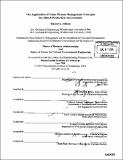| dc.contributor.advisor | Jonathan Byrnes and Deborah Nightingale. | en_US |
| dc.contributor.author | Allison, Daniel J | en_US |
| dc.contributor.other | Leaders for Manufacturing Program. | en_US |
| dc.date.accessioned | 2006-11-08T16:30:45Z | |
| dc.date.available | 2006-11-08T16:30:45Z | |
| dc.date.copyright | 2004 | en_US |
| dc.date.issued | 2004 | en_US |
| dc.identifier.uri | http://hdl.handle.net/1721.1/34745 | |
| dc.description | Thesis (M.B.A.)--Massachusetts Institute of Technology, Sloan School of Management; and, (S.M.)--Massachusetts Institute of Technology, Dept. of Civil and Environmental Engineering; in conjunction with the Leaders for Manufacturing Program at MIT, 2004. | en_US |
| dc.description | Includes bibliographical references (leaves 94-95). | en_US |
| dc.description.abstract | The need for continuous improvement within a value stream is very necessary in today's business environment and can be one of the key sources of competitive advantage. As a company learns and implements the tools and practices of a Lean system, the underlying management and leadership methods become critical to sustaining fundamental operational change. A Value Stream Manager provides this leadership and is responsible for increasing the ratio of value to non-value by eliminating waste in the overall value chain from start to finish. The scope of the responsibilities of a value stream manager should cover at least two domains. First is the plant domain, that improves the value stream between the four walls of the plant; including the inbound and outbound logistics to/from the plant. The second domain is to consider the value stream at the enterprise-level. At the enterprise-level, the value stream manager is responsible for eliminating waste throughout the extended value stream, including channel partners such as suppliers and customers. This thesis will examine the operations of the ABB Wessel Cable plant in Longford, Ireland and analyze the application of Value Stream Management principles during a six and a half month internship period. By involving all the employees at ABB Wessel we were able to reduce WIP and Finished good levels down to historic lows holding scrap below 4% and increase overall equipment effectiveness by almost 30%. By concentrating on velocity of flow through the factory with reduced overtime, the business stopped losing money. In the proposed future state, additional performance enhancing changes are identified and discussed as a going forward plan for the future. | en_US |
| dc.description.statementofresponsibility | Daniel J. Allison. | en_US |
| dc.format.extent | 113 leaves | en_US |
| dc.format.extent | 7413877 bytes | |
| dc.format.extent | 7425382 bytes | |
| dc.format.mimetype | application/pdf | |
| dc.format.mimetype | application/pdf | |
| dc.language.iso | eng | en_US |
| dc.publisher | Massachusetts Institute of Technology | en_US |
| dc.rights | M.I.T. theses are protected by copyright. They may be viewed from this source for any purpose, but reproduction or distribution in any format is prohibited without written permission. See provided URL for inquiries about permission. | en_US |
| dc.rights.uri | http://dspace.mit.edu/handle/1721.1/7582 | |
| dc.subject | Sloan School of Management. | en_US |
| dc.subject | Civil and Environmental Engineering. | en_US |
| dc.subject | Leaders for Manufacturing Program. | en_US |
| dc.title | The application of value stream management principles in a batch production environment | en_US |
| dc.type | Thesis | en_US |
| dc.description.degree | S.M. | en_US |
| dc.description.degree | M.B.A. | en_US |
| dc.contributor.department | Leaders for Manufacturing Program at MIT | en_US |
| dc.contributor.department | Massachusetts Institute of Technology. Department of Civil and Environmental Engineering | |
| dc.contributor.department | Sloan School of Management | |
| dc.identifier.oclc | 56606312 | en_US |
